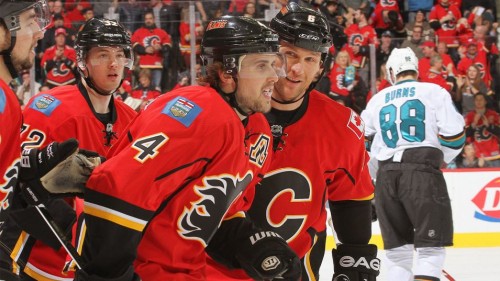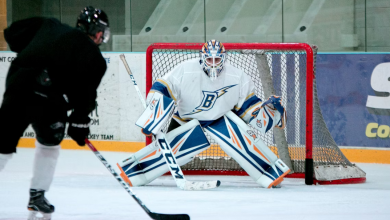Calgary Flames making a serious run for the 2015 NHL Playoffs

The Calgary Flames took a big step forward in their 2015 playoff hunt earlier this week.
Lance Bouma, Jiri Hudler, Mason Raymond and David Jones all scored goals to help the Flames leap a little higher in, whilst Jonas Hiller played like a man possessed by making 33 saves to help Calgary move up to second place in the Pacific Division. This was courtesy of an overall 4-1 victory over the San Jose Sharks at SAP Center.
Calgary has now seen their odds shorten right down to 32-1 with Betfair. The Chicago Blackhawks are still at around 8/1, followed by the Anaheim Ducks, Pittsburgh Penguins, Boston Bruins, Los Angeles Kings, St Louis Blues, Montreal Canadiens, Tampa Bay Lightning, Vancouver Canucks, San Jose Sharks (still ahead of Calgary despite the loss), Nashville Predators, Minnesota Wild, the New York Rangers, the Detroit Red Wings and the New York Islanders. Only then do we get to the Flames. No other team is given a realistic chance.
So, perhaps the market has it right, but we’ve seen so many occasions in the past when this hasn’t been the case and Flames fans may well want a little piece of that action on a hopeful basis!
That is because the Flames were tremendously impressive with their win in San Jose. And, with the win, they moved past both the Vancouver Canucks and Sharks in the Pacific league. As things stand at the time of writing, both San Jose and Calgary now have 63 points each, although the latter have a crucial game in hand. Vancouver, meanwhile, have 61 points.
With the win, Calgary overcame the Sharks for the fourth time in just five matches. They also managed to win the final game of their season’s series.
The Flames went 3-0-0 at the SAP Center. This means they won three games in a single season at the venue for the first time since way back in the 1995-96 NHL season.
Flames captain Mark Giordano was in no doubt of how big of a deal the win was given that his side was even on points with the hosts. This was also the first hockey game of Calgary’s yearly fathers’ road trip. And the presence of all the dads in the crowd really seemed to help get the visitors going psychologically. It’s a beat trick other teams may decide to emulate for such crucial away games in particular.
For Swiss goaltender Hiller, it was the second win over San Jose in just a six-day period. The 32-year-old keeper enjoyed no fewer than 28 saves in Calgary’s 3-1 victory over the San Jose Sharks the previous week.
Brent Burns netted for San Jose (28-20-7), but didn’t manage to prevent his side from losing for the fourth time over the previous five games (1-3-1). The visitors went one for three on the power plays whilst the home side was blanked in all three of their attempts.
Mason Raymond managed to give the Calgary Flames a 1-0 lead at 14:52 in the first period. He almost skated coast to coast as he scored his ninth season goal. The 29-year-old Canadian left winger raced down the left before cutting inside to beat Sharks goalie Antti Niemi via a deft wrist shot from the slot.
The visitors managed to outshoot San Jose 8-7 during the first period, and appeared overall to be the faster team, generating far more scoring opportunities along the way.
Calgary upped their lead to 2-0 at 8:10 in the second period as Bouma hit a rebound straight past Niemi from point-blank range. Meanwhile, Mikael Backlund won a face-off with James Sheppard, then Jones got the puck out to Giordano, who shot from the left circle while Bouma planted in front. The 24-year-old Canadian centre / left wing was then stronger than the Sharks’ rookie defenseman Mirco Mueller, smacking in the rebound squarely for a ninth goal of the season.
Calgary Flames coach Bob Hartley was naturally delighted with the win and with the way his players fought so hard against their fierce league rivals away from home. He cited his team’s overall strength and sheer determination as key factors in the win.
Calgary looked like they were heading into the second intermission with a two-goal lead, but then 29-year-old Canadian Brent Burns netted for the home side at 19:59 of the period.
With only four seconds remaining, Joe Pavelski won a face-off with Calgary’s Sean Monahan at the visitors’ end and managed to send the puck to Logan Couture along the right boards. Couture turned quickly and passed to Burns. Burns managed to beat Hiller with a slap shot from the blue line.
But the visitors regrouped and completely dominated the third period, with two goals without reply from San Jose. Then Jiri Hudler scored from the slot at 5:20 in the third period to increase the visitors’ lead to 3-1 and the game was all but over. When David Jones scored an empty-net goal with just 1:53 left on the clock, it was the icing on the cake to seal a memorable win for Calgary which very much keeps their Stanley Cup playoffs dream alive.
The Flames last won the Stanley Cup outright in 1989 when they beat the Montreal Canadiens 4-2 in games. Calgary was a little less fortunate just over a decade ago when they lost the 2004 final to Tampa Bay Lightning and they haven’t been all the way since then. Maybe 2015 is the year the Flames will really light things up once more?

